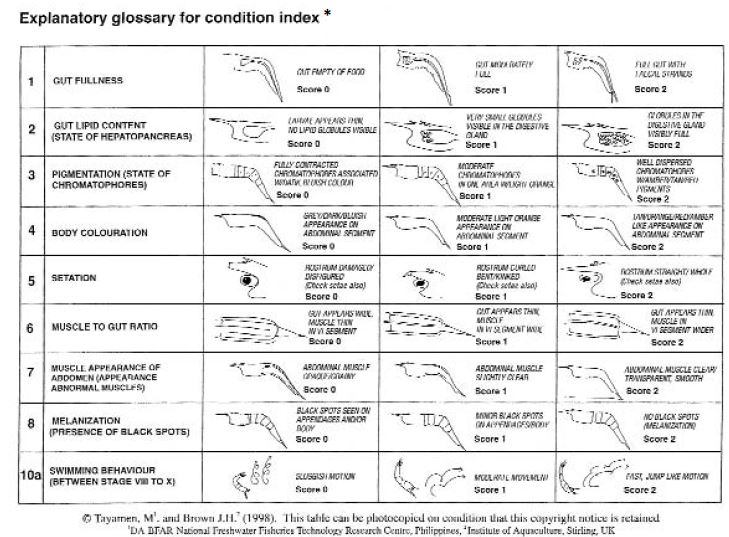MONITORING PERFORMANCE
Many hatchery operators judge when to make changes in the feeding regime, for example, by the number of days that have elapsed since the larvae were stocked. This is satisfactory if a larval batch is performing well and you are basing your management on previous experience. You can judge the progress of your larvae more accurately by stereoscopic microscopic examination. You should do this on a daily basis until the first PL appear in the tank. A key to the various larval stages is provided in Annex 1.
You will very quickly become able to gauge whether your larvae are feeding and growing well by crude visual examination, using a white sight board (Figure 33) and observing the behaviour of the larvae. Healthy larvae swarm at the surface of the water (especially in the first 10 days) when the aeration is turned off, feed actively, have a redbrownish pigmentation, and are not observed to cannibalize. Unhealthy larvae accumulate at the bottom of the tank and are often bluish in colour. Food consumption drops and, if the problem is already severe, you will see dead larvae. Healthy larvae swim tail first, head down and ventral side up. Metamorphosis to PL is characterized by a radical change in behaviour and appearance; for the first time the animals resemble miniature adult prawns and, instead of swimming freely in the water, many crawl or cling to the tank surfaces.
The performance of freshwater prawns during the grow-out phase depends on the history of the PL or juveniles stocked. It is therefore important, if your hatchery is to establish and maintain a good reputation for high-quality PL, to monitor the condition of your animals. A new method to score the condition of M. rosenbergii larvae was developed by Tayamen & Brown (1999). This is based upon microscopic examination, followed by scoring on a condition index using a numerical scale. Larvae scoring high on this system have been demonstrated to show better growth and survival in various Southeast Asian hatcheries.
The scoring system is illustrated in Figure 36a and a larval quality record sheet in Figure 36b.
Although survival rates of up to 80% between stage I and metamorphosis to PL have been claimed by some hatcheries, 40-60% is more normal in practice. The time taken for a larval batch to metamorphose varies according to feeding and environmental conditions, particularly temperature. In a healthy, well-fed batch, which is maintained within the optimum temperature range, you should expect to see the first few PL between days 16-20 after stocking. Most of the larvae should have metamorphosed into PL by days 25-32 at the recommended water temperature of 28-31°C. Some hatchery operators wait for the last few larvae to metamorphose before harvesting but it is not usually economic to maintain any batch longer than 32-35 days (by which time 90-95% metamorphosis should have
FIGURE36a
A method of evaluating the quality of Macrobrachium rosenbergii larvae is illustrated in this diagram

* [CRITERIA Nos. 9 AND 10b ARE NOT ILLUSTRATED IN THIS TABLE; SEE FIGURE 36b]
SOURCE: TAYAMEN AND BROWN (1999), REPRODUCED WITH PERMISSION FROM BLACKWELL SCIENCE
FIGURE36b
This form provides a convenient way of recording your observations on the quality of Macrobrachium rosenbergii larvae

SOURCE: TAYAMEN AND BROWN (1999), REPRODUCED WITH PERMISSION FROM BLACKWELL SCIENCE
occurred). You are therefore recommended to terminate each larval batch after day 35, at the latest. This releases your equipment so that you can prepare for the next larval batch.
Some hatchery operators transfer the remaining larvae from the original batch to another smaller tank to wait for them to metamorphose but this is not recommended.